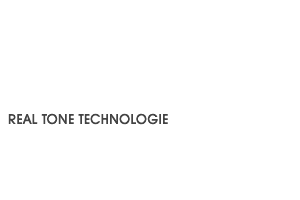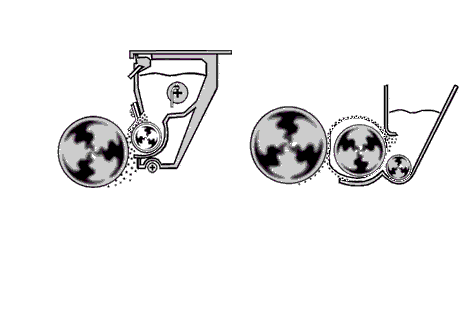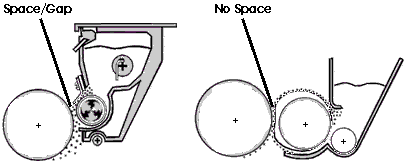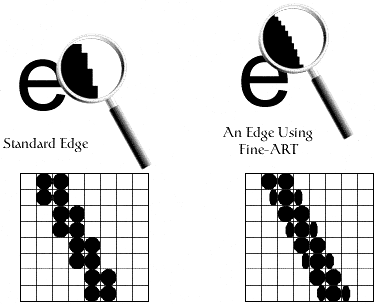| Patented contact sleeve developing process that produces rich and consistent image quality | |
| Edge smoothing technology that delivers sharp, crisp and clear defined text and images. | |
| With Adobe PostScript, Minolta RealTone delivers highly defined photographic images that look photo-realistic. | |
| Minolta printers offer advanced memory compression technologies for faster throughput and a reduction in memory requirements for printing complex documents and graphics. | |
| Minolta's technologies offer products that are gentle to the environment, while enhancing product quality and performance. |
Super Fine Micro Toning is a unique technology developed by Minolta that utilizes a contact development sleeve, that allows for richer and more consistent black output compared to ordinary monocomponent processes. This contact sleeve development technology resembles a professional off-set printing system offering extremely high print quality. Also, by incorporating this companies to offer all-in-one, easy to replace and clean hands, toner cartridge systern.
Minolta's Super Fine-MT system uses a unique patented contact sleeve that makes direct contact between the developing cylinder and the photoreceptor drum allowing for consistent transfer of toner. The sleeve is a soft material that allows for a more stable contact that does not damage the photoconductor drum.
Compared to other technologies that utilize the jumping method, Minolta's developing system has features unique to the technology:
The Fine-MT is a proven technology found in laser printers sold throughout the world under the Minolta brand name, as well as various OEMs (including several in the U. S. market). The remarkable technology is the base technology for Minolta's 3rd generation of printers, the PagePro series.
The Super Fine-MT process is characterized by the use of a cylindrical flexible sleeve for the development sleeve. The driving roller fits within the flexible sleeve. The sleeve is rotates around the driving roller. At the same time the sleeve forms a swell that is fits loosely around the driving roller surface toward the photoreceptor, resulting in the precisely aimed soft contact type development.
The flexible development sleeve is driven by the friction
generated between the inner surface of the sleeve and the driving roller surface. This is
due to the pressure of both the sleeve guides and the regulating blade onto the sleeve.
Tension springs in the upper ends assure uniform pressure to the sleeve surface to make it
form a stable swell for a consistent transfer of toner.
Figure 1.
No Edge Effect
Some technologies that utilize ordinary monocomponent
developing systems, force toner particles to fly from the developing cylinder onto the
photoconductor drum. With these types of systems there usually is a space between the
developing roller and drum. When this space exists it allows for the electric field to go
around beyond its designated target, making the charge of the latent image’s edge
stronger than nonnal. This results in a higher concentration of toner applied to the
edges, giving a darker and uneven effect from the center of the image.
Since Minolta's Super Fine-MT technology provides direct contact of the sleeve developing
roller and the photoconductive drum, this edge effect is avoided and sharp lines and
images are produced.
Figure 2.
Sharper Images
Minolta's Super Fine-MT system charges toner with stronger friction resulting in a stronger and heavier charge. This allows for the toner to be attracted and deposited to the photoconductor drum with more accuracy, eliminating the scattering effect attributed to other technologies.
Small Particle Toner
Minolta utilizes small particle toner, 8 ╡m for the PagePro series 600 dpi printers: forrnerly 11 ╡m toner. This achieves the best print quality with the combination of 600 dpi resolution, Fine-MT developing system and Fine-ART smoothing technology. Figure 3.
Minolta's Fine-ART technology is a clock doubling ASIC designed to smooth 600 dpi text and vector graphics to give the appearance of 1200 x 600 dpi output. This technology is utilized in the Minolta PagePro printers in either PCL 5e mode or for the PW-6e it is also utilized in its QuickPage mode.
The Fine ART ASIC is resident within the printer controller and is designed to interpolate 600 dpi data received from the host computer. Once the font or vector graphic inforrnation is sent down to printer and passed through the video controller, the 600 dpi horizontal dot information is translated into a 1200 dpi space.
In the case of the PagePro, the host
computer only has to send down 600- dpi information to be processed by the PCL code. This
interpolation only occurs on the edges of scaleable fonts and vector graphics. The 600
horizontal dpi grid space is then redefined into a 1200 dpi grid space. This is where the
interpolation begins. Once the edge information is examined by the ASIC, it takes the dot
information of the edges and creates half size dots (I/1200"), where needed, to a
"Best Fit" algorithm in order to create a smoother, sharper and cleaner image.
Figure 4.
Superior Print Quality
The combination of Minolta's Super Fine-MT, Fine ART and small toner particle size offers customers a superior quality laser printer that is unique in the industry.
With PostScript delivers highly defined photographic images that look photo- realistic. Minolta's RealTone enables precise control of the laser beam to provide a construction of gamma correct halftones at multiple screen frequencies. This allows for dots in a 600 dpi PostScript photographic image to have the appearance of 2400 dpi quality. Other technology benefits include:
• Photo-realistic images with up to 256 shades of gray
• Up to 212 line screens
• Image quality equivalent to 2,000 dpi typesetter
• High speed halftone algorithm provides fast throughput
• Requires half the memory of 1200 dpi images
Each of the Minolta PagePro printers offer some type of memory reducing or memory compression technologies that impact the amount of memory required to print out a page. Types of memory compression vary from model to model, some utilizing techniques of "on-the-fly" software compression to processor based compression; each resulting in the net affect of reducing the amount of memory required.
Color PagePro - Memory Reduction Technology«
Memory Reduction Technology reduces the amount of required memory by converting each page in the document to a compact list of objects. These objects are stored independently for maximum reduction in space without impacting performance. The result is high performance, superior print quality color with very little memory.
Color PagePro Object Based Image Processing
Conventional color printer technologies
treat all graphic objects - lines, text, and images the same. This regular method results
in severe compromises in print quality and performance A direct trade off typically has to
be made between high resolution and fewer printable colors, or lower resolution and more
colors. Unfortunately text and line art demand the highest resolution possible for smooth,
crisp edges; whereas, photographic images are best reproduced with each pixel representing
a large number of colors.
Conventional color printers render all graphics at a single resolution and
color depth. A tradeoff is made between text, line art and image quality.
Object Based Imaging enables the software to select the optimal rendering
technique for each graphic object. Printers developed with this technology are able to
image crisp, clear text, as well as smooth, photo-realistic images all on the same page
with a fraction of the memory required compared to competitive products.
(Memory Reduction Technology is a registered trademark of Peerless Systems Corporation)
Ozone free operation
Minolta's printers are virtually free from ozone emission. A brush charging
system which enables close charging, eliminating unnecessary electric discharge is used
instead of corona-wire type charging systems.
Energy Star Compliant
All Minolta PagePro Printers comply with the Energy Star standard for
energy saving electronic equipment.
Waste Reduction
Because the PagePro 6 series utilizes a two-in-one cartridge system, there is less waste to the environment. Since the toner cartridge and the drum cartridge units are separate you only have to replace the imaging cartridge when you run out of toner. Since the drum cartridge lasts for 20,000 pages, you only have to replace it after 7 imaging cartridges are used. This means less waste and an overall cost reduction to you.








